9420
Views & Citations8420
Likes & Shares
The study focused on cropping and management techniques of chili production under rain-fed farming condition to assess farmers’ opinion based on the performance of standing crops. It was conducted at Wookhana, Punakha District, Bhutan, an area with 27 farming households. From this population, 23 farmers were interviewed in pre-test interviews and 20 were participated in the post-test interviews, derived population size from Krejcie and Morgan. Pre-requisite for the post-test, an experiment of 4x4+1(control) factorial using RCBD was conducted to the participating farmers. The collected data was analyzed according to a knowledge coding scheme with comparison between pre-test and post-test outcomes and by applying common test analysis. The result showed that all the participating farmers had pre-knowledge of raised bed cultivation of chili and 78% of farmers on intercropping of chili with beans. However, none of the farmers had pre-knowledge of pruning methods, 1st bottom three flower removal of chili plants, and different planting bed types. One-day demonstration was held near the end of the growing season during the harvest period. Following the demonstrations, the majority of farmers accepted and would adopt on an on-going basis, the modified raised bed (90% farmers) that had developed and 1st bottom three flower removal process under modified raised bed (50% farmers). However, a few farmers seemed to accept the pruning method and intercropping in modified raised beds tactics reluctantly. The comparison analysis between pre-test and post-test interviews showed no significant differences (p>0.05) on perception of modified raised bed (MRB), intercropping of beans in MRB, removal of 1st bottom three flower in MRB, but significant difference (p<0.05) on pruning of chili in MRB. This study has provided farmers with well-tested crop improvement methods under rain-fed farming which were well received by the majority of the farmers.
Keywords: Modified raised bed, Intercropping, Pruning, Flower removal, Rain-fed
INTRODUCTION
Applying scientific and farming knowledge in science [1] by a cropping system designed for the management of crops to maximize benefits from given resources and inputs is essential, and must reflect local environmental conditions [2].
A cropping system for chili production comprises various management techniques such as differently constructed raised beds and intercropping with other crops, specifically beans in this case. Saving water and retaining soil moisture, optimizing chemical nutrients application, such as nitrogen, and increasing crop yields require differently constructed raised beds to those traditionally used in chili production.
These research reports support the importance of developing and adopting particular cropping techniques such as intercropping, cultivation and land management methods to maximize crop yields and therefore incomes. Particularly, intercropping chili with beans under different raised bed structures were considered to be a priority for evaluation for chili production.
Research on chili cropping by Alsadon [3] considered crop management practices in chili crops to augmenting the plant growth and fruit yield. Shoot pruning and removal of chili flowers were two important practices identified. Shoot pruning is important in the proper management of the crop to balance the heavy vegetative growth and fruit load of the chili plants. According to Jovicich [4] removal of the first two flowers also augments root development with consequential enhanced vegetative growth before fruit set. It has been well demonstrated that a well-developed root system with increased vegetative growth enhances fruit size and subsequent fruit yield. Under rain-fed farming conditions, with the often-erratic rainfall, poor development of the root leads to inadequate water and nutrient uptake which affects yield and the quality of fruit. Maboko [5] regarded pruning to two or three stems as an effective cropping management to enhance yield and fruit size of chili.
Chili is one of the major crops cultivated in 20 districts of Bhutan. The chili growing area has been expanded over a decade, owing to the importance of chili crops. In 2016, the growing area was 5,538 acres with yield of 9,907 metric tons (MT) whereas in 2017 the area had expanded to 7,571 acres with yield of 13,606 MT. It is now the second most cultivated crop in Bhutan, by area under cultivation, after potatoes. Chili is commonly used in various national cuisines, being used in various forms such as dry, powder and paste [6]. Farmers growing large scale chili cultivation are solely dependent on the cash income from the sale of their crops.
Chili grown on a commercial scale is cultivated under rain-fed conditions even though the rainfall unreliable, irregular and unpredictable. Cropping, land use and management techniques are necessary to address the threat of limited rainfall. Moreover, these techniques must be able to be taught to farmers and easily adopted by them.
Given the importance of this crop to the national economy of Bhutan, and particularly to the many large and small farmers dependent on income from chili cultivation, the objectives of this study were 1. to identify and comprehend the level of knowledge of farmers on cropping and management techniques, and 2. to convince and encourage farmers to adopt some useful techniques that had developed and studied.
Population, Sample Size (Pre-test and Post-test sample) and Area
The sample size was based on Table 1 drawn by Krejcie [7] with the population proportion of 0.05 and confidence of 95% with significant difference of 5%. At Wookuna village, Kabisa Block, Bhutan, there were 27 households. Using Krejcie and Morgan’s Table 1, 24 house hold was selected to participate. However, a member from one household were not available for an interview, so the actual number of participants was 23 in the pre-test interview.
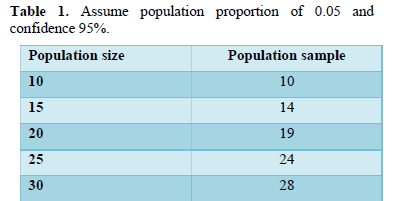
Pre-Test interview (questionnaire)
Pre-test questionnaires with questions on participants’ demographic profile, the cropping system that they followed, their cultural management practices, and adoption on the technologies. The pre-test interview was conducted on 1st week of April, 2019.
Field Experiment
A field experiment was conducted to identify and assess the effectiveness of their cropping and management techniques under rain-fed farming conditions. It was conducted from March until July, 2019.
Construction of Raised Plant Beds
The experimental design was 4x4 + 1 (control) factorial of randomized complete block design with three replications using growing beds 2m x 1m in size. For experimental purposes, constructed raised beds with specific structures i.e., raised borders or berms on all sides (modified raised bed) and traditional farmer’s raised bed, 25 cm in height, 1 m wide and 2 m long were used for comparison purposes. Modified raised bed had the same dimensions the farmers raised beds but with the ridge or berm all around, 10 cm wide and 10 cm high. An intention in using the berm was to retain moisture loss by run-off from the raised bed, to also avoid deterioration of the raised beds caused by water run-off in heavy rain conditions, and to thereby prevent nutrient loss by being washed out of the raised bed by water run-off.
Plant Cropping and management Techniques Demonstrated
The plant management techniques being demonstrated and assessed included pruning of chili plants after one month from initial transplanting, pruning meant removal of all growth above 20 cm by cutting the stem at that point. The second technique was done at the flowering stage, when the 1st bottom three flowers were removed. The third aspect was sowing an intercropping crop one month after the initial planting of the chili. A local variety of semi dwarf beans was used as the intercropping crop species.
The cropping techniques tested and compared included.
- Chili planted in farmers raised beds’
- Chili planted in modified raised bed (with the surrounding berm)
- Intercropping of beans under chili planted in farmers raised beds
- Intercropping in modified raised bed
- Chili planted in farmers raised bed only (control).
Plant management techniques tested and compared included
- Pruning of chili grown in farmers raised beds
- Pruning of chili grown in the modified raised bed
- 1st bottom three flower removal in farmers raised bed
- 1st bottom three flower removal in modified raised bed
- No management technique in farmers raised bed (control).
Pre-Harvest Field Day
A field day was conducted before harvesting the current crop. The participating farmers were briefed on the objectives of the research and on the cropping and plant management techniques that had been used and were given a demonstration on the plant management techniques: pruning of plants and 1st flower removal in different raised beds, and intercropping. The farmers were then asked to observe the test plots. They were also briefed about modifying raised bed technology needed for the rain-fed farming.
At the end of the field day, each farmer was individually interviewed based on a semi-structure post-test questionnaire.
Post-Test interview (Questionnaire)
In the post-test questionnaire, the demographic profile of each farmer was affirmed, and their views and opinions regarding the day’s activities were discussed. They were asked to rate the outcomes that they had observed, in each of the test plots, in terms of plant growth, plant health, number of fruits, fruit size and over-all yield. The likelihood of each farmer to acceptance and adopt the techniques, or not, was ascertained and discussed and their reasons for that response identified. Of the original 23 participating farmers, only 20 participated in this post-test interviewing.
Code for Analysis
The responses provided by the farmers were analyzed using code index for analyses. Based on the farmers respond on decisions and their acceptance or rejection on techniques, the code index for analysis were categorized into eight groups as follows (Table 2).
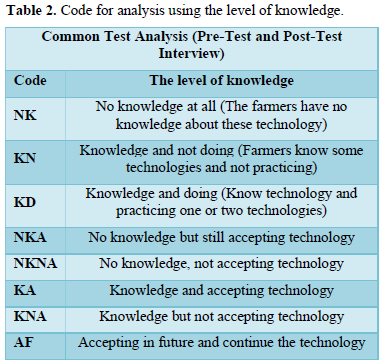
Data for common test interview was interpreted in excel-sheet in the form of graph and analyzed using chi-square test using statistics 23 to find the significant different (p=.05).
RESULTS AND DISCUSSIONS
Of the 23 farmers who initially agreed to participate in the research, and who had completed the pre-test interviews, 3 participants did not attend leaving only 20 to participate in the post-test interviews. The following figures are for the pre-test cohort.
Demographic Profile
Gender Participation
The demographics of the participants were 74% were female and 26% male (Table 3). By age, 26% were in the age group of 31-40 and also 26% aged between 41-50 (Table 4). This age group were middle-aged farmers who were decision makers in regard to the adoption of the techniques and other work practices (Table 3). The similar finding reported by Olayiwala [8] that the middle age persons were more interested in growing chili.

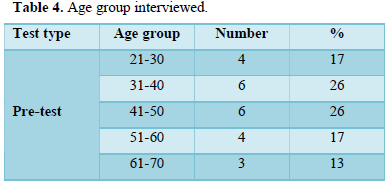
Education Level
The data showed 65% of the respondents were illiterate while 22% had achieved primary education, with only 13% entering higher education levels as shown in Table 5. Thus, the majority of participating farmers represented from the illiterate group who actively involved these activities. However, Olayiwala [8] stated that the majority of farmers were educated who participated in growing chili.
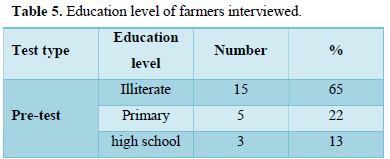
Farm Size
The result showed that 52% of farmers owned area ranges between 2.1-3 acres while 4% owned the highest area of 7 acres (Table 6). The study signified that majority of the farmers owned medium plots for chili cultivation. Similar finding shown by Olayiwala [8] that the majority of farmers owned medium farm size of 1.26 to 2.5 acres of land who were more interested in chili cultivation.
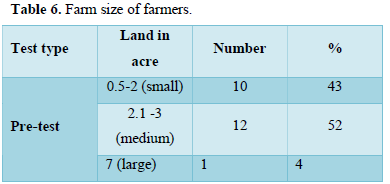
Chili Cultivated Area
The finding revealed that about 52% of farmers cultivated in less than one acre while 17% of farmers cultivated in two acres (Table 7). The finding stated that most of the farmers grew chili less than an acre even though majority owned 2.1-3 acres of land. According to Xinhua [9] famers of Bhutan cultivate 50 decimals to one acre of land generating approximate 2000-4000 kgs of yield.
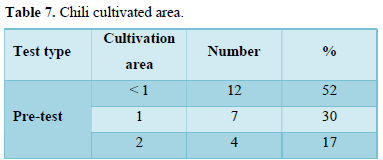
The data showed that majority of farmers (70%) cultivated for subsistence and commercial purpose and (70%) majority of farmers sold chili to capital (Thimphu) of Bhutan (Table 8). Farmers explained that they fetched higher price selling in the capital than in local market. Most of the farmers preferred chili as a cash crop, since it fetched high potential returns and achieved profit in one season [10].
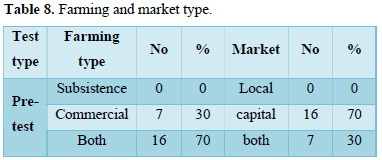
Land Type and Cropping Type
About 83% of farmers cultivated chili in wet land while 13% cultivated in wet and dry land (Table 9). Where wet land was under cultivation, chili was cultivated in rotation with paddy. About 78% of the farmers rotated chili after paddy, 9% rotated potato with chili, 9% with cabbage after chili, and 4% farmers rotated with chili with wheat. The result demonstrated that the majority of the farmers were practicing good agriculture practices by rotating chili with paddy crops, a practice recommended in [11] as for controlling soil borne pathogens and weeds. Similar finding reported by Ning [12]. The fact that the farmers did practice such crop management techniques meant that we were optimistic that they would be willing to adopt our land and plant management methods after we had demonstrated them.
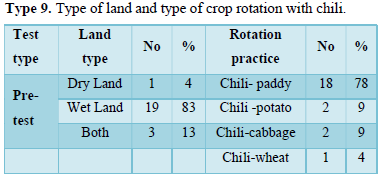
Raised Bed Method
The farmers (100%) conducted conventional farming by raised beds. About 83% of farmers raised beds for good drainage, 9 % to ease cultural operations, 4% for high yield and 4% recommended by extension. According to the finding of Groenman-van [13] the raised bed technology provided drainage and improved fertility and microclimate. Miah [14] stated further that farmer used to raise bed technology due to the reduced amount of various production inputs such as irrigation water, seed, fertilizer, and labour and facilitated easy intercultural operations like weeding and insecticide application. The similar finding was reported by Hobbs [15] and Fahong [16]. Therefore, raised bed technology aided more ideal planting time, better drainage, reduced the seed rate with less irrigation water requirement, imparted higher nitrogen use efficiency, reduced crop lodging, and increased crop yield [14].
Coding the results for analysis
As shown in Table 2, the farmers responses were coded for analysis. The coding included the farmer’s level of knowledge of the cropping and plant management techniques being demonstrated to them, and also intention to adopt the methods and technology. The first five coding were for pre-test interview and the last three coding were for post-test interview.
- NK- no knowledge
None of the farmers had any knowledge of the type of raised beds. However, all the farmers had knowledge about the raised bed method and advantages of raised bed method. None had previously seen the pruning and flower removal demonstrated, and 22% of farmers had no idea about intercropping with beans and their benefits. Rest of the farmers had understood about intercropping and its advantages. However, farmers stressed that intercropping with beans were being consumed by monkeys.
- KN- Knowledge but not doing
About 56% farmers knew about intercropping of chili with beans but they did not practice, with 21% identifying depredation by monkeys as the reason, 13% of the farmers stated that the chili plants were being covered and flattened by beans plants, 13% found that staking of semi-beans was time-consuming and 9% highlighted that since most of the farmers were not practicing intercropping, they followed the majority and did not practice. However, few farmers (22%) who could not grow beans as an intercrop with chili due, oddly, to potential depredation by monkeys from nearby forest areas where settlement was located. The similar finding showed that in the field near forested core areas face problem with higher damage from the wild animal as expressed by Wang [17]. Sahoo [18] reported that the distance parameter between farmland and forest also showed the severity of the damages to the field. The field beyond 1000 m distance from the forest caused a small percentage of crop damage by monkeys and field between 300-1000 m vicinity caused serious problems in rural areas. Therefore, an investigation on agricultural crops damaged by wild animals become a main issue [17]. Thus, this study found that the participating farmers’ solutions were to avoid intercropping chili with beans since bean crops were easily damaged by monkeys affecting the main crops as well.
- KD- Knowledge and doing (farmers know some techniques and practicing at least one or two techniques).
All the farmers had knowledge of using raised beds for chili crops and even since, they have been practicing. Farmers (78%) had knowledge on intercropping with beans out of which 22% of farmers were practicing since their fields were located near their houses. They found that harvesting two crops generated more income. The similar result was shown by Stagnari [19]. They further mentioned that intercropping beans are highly suitable due to atmospheric nitrogen fixing ability providing low input cropping system, mitigating greenhouse gases emissions and breaking the life cycles of pest and diseases, thus reducing pest and disease incidences.
- NKA- No knowledge but still accepting the technology.
The farmers had no knowledge on pruning and flower removal. After providing knowledge, and information on pruning, flower removing, intercropping of beans and modified raised bed, during the pre-test interview, farmers accepted these techniques. Majority of the farmers (96%) accepted about flower removing, about 96% of farmers accepted pruning, 74% farmers accepted modified bed and 17% accepted intercropping with beans to carry out in future if all of them provided healthy plant stand with high yield. The farmers who accepted intercropping were those whose fields were located near their houses. Most of the farmers who accepted the techniques in the pre-test interview were because of disseminating information on advantages of the techniques such as 1. pruning chili promoted strong stems, good branching, reduced disease and pest, early and evenly ripening of fruits and improves yields. 2. removing first few flowers improved root growth diverting an energy to produce flowers and fruits. 3. bed planting enhanced crop yields and saved irrigation water to augment water productivity [20]. 4. intercrop chili yields were higher than sole chili yield signifying positive effects from beans.
- NKNA- No knowledge and not accepting the technology.
About 4% of the farmers did not accept the pruning techniques even after being provided with information, giving the reason that they had no work-force and no time for pruning. 26% of farmers did not accept modified raised bed said that they have not seen the modified bed and cannot justify while some explained that they are comfortable with the existing raised bed system. About 27% of farmers who did not accept intercropping of beans said that their fields being attacked by monkeys and 4% of farmers who did not accept 1st bottom three flower removal said that removing flower being one of the hectic tasks requiring more labour force. Singh [21] recorded those unpruned plants had a greater number of fruits per plant than pruned plants. Likewise, pigeon pea had flowered 6-21 days earlier (p<0.05) in un-pruned plot than pruned treatment. Pigeon pea pruned to 25 cm had the least percentage survival. Moreover, yield was the highest in un-pruned plot and least in plot pruned to 25cm [22]. The major sources of crop losses were wild animals such as monkeys and feral pigs [23].
- KA- Knowledge and accepting the technology
After the field observation and demonstration, 90% of the farmers accepted the modified raised bed structure, and 45% of them accepted intercropping in modified raised, 70% of these also accepted the pruning techniques in modified raised bed, with 50% accepted 1st bottom three flower removal in modified raised bed. Of those who accepted the modified raised bed, 80% found good plant growth and yield and 10% found uniform with larger fruit size. Farmers who accepted pruning and intercropping of beans in modified raised are for trial purposes with the stated intention to continue with the practice if they see improved crop performance. The farmers who accepted 1st bottom three removal of flowers found high number of fruits per plant with uniform and larger fruit size. The farmers statement regarding few flower removal could be true since the study conducted by Maboko [5] found that the first two flowers removal of chili enhanced root development which further increased fruit bearing and fruit size. Ghebremariam [24] reported that removing some flowers or fruit from chili crop depicted in assimilating re-distribution to the remaining fruit, accelerating their size.
The majority of the farmers observed excellent growth and yield parameters in the modified bed and 1st bottom first three flower removals in modified bed (Annexure Tables 1-5).
- KNA- Knowledge but not accepting the technology
Of the farmers who had knowledge of all the technologies, about 10% of the farmers did not accept the modified bed structure, 55% did not accept intercropping with beans, 30% did not accept pruning and 50% did not accept 1st three flower removal.
The farmers stressed that preparation of the modified raised bed needed more labour force (5%) and was time consuming (5%). They also stated that intercropping chili plants was not healthy leading to the low yield (20%), not uniform (15%) and more labour requirement (15%). Ouma [25] also reported that intercropping required more labours and intercropped plants competed for water, light and nutrients resulting in lower yields. They (15%) explained that pruned plants had no uniform fruits and had low yields, some (9%) said that plants were weak and diseased, and few (6%) highlighted pruning required more labor-force and was time consuming. The farmers emphasized that removing flowers required more workforce (15%) and time consuming (35%).
- AT- Accepting the technology (farmers accept at-least one or more technologies
Two important techniques, the modified raised bed and 1st bottom three flower removals in modified raised bed were prioritized by the farmers based on the plant growth, plant health, number of fruits, fruit size and overall yield. 90% of farmers wanted to continue with the modified raised bed and 50% of farmers wanted to conduct 1st three flower removal of flowers in modified raised bed. When farmers were probed further for accepting the modified bed technology, farmers (48%) mentioned that the good yield could be due to good of soil moisture content under rain-fed condition, 26% said that this could be due to mulching with organic manure and the rest claimed that this could be due to nutrients and moisture. According to Miah [14] raised bed technology has been proved as a water saving technology and required less irrigation water (Table 10).

Modified raised bed versus Farmer’s raised bed type
The followings are the rating based on performances of chili crops on cropping and management techniques under modified and farmer’s raised bed. The result defined that farmer (100%) preferred modified raised bed over farmers raised bed. Participating farmers observed positive benefits of the modified raised bed and became enthusiastic towards this technology. The similar study conducted by Miah [14] found that 30.8% of adopting farmers modified their bed size (width of the bed and furrow) with 29.2% shortened bed width and 8.7% shortened the furrow width were effective in production, originally learnt from scientists.
Table 11 showed that all the farmers preferred modified raised bed and majority (70%) of farmers preferred 1st bottom three removal of chili in modified raised bed over farmers raised bed. The reasons for accepting modified raised bed by the farmers are due to rating performance of good plant growth (80%), number of fruits per plant (75%), uniform size fruits (80%), healthy plant stand (80%) and overall yield (75%).
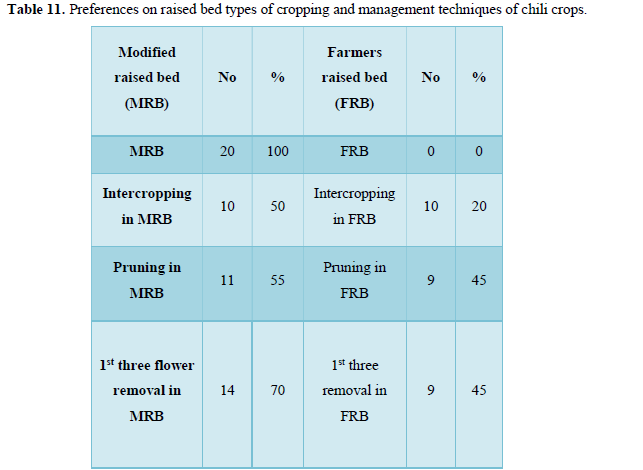
Common Test Analysis
The common test analysis was based on farmers’ preferences on modified raised bed between pre-test and post-test interview. Table 12 showed that the acceptance on modified raised bed between pre-test and post-test interview was not significantly different (p = 0.666). Therefore, there was no significant association between interviews and acceptance on modified raised bed. The Figure 1 showed that percentage of farmers accepting modified bed were found higher in post- test (90%) than pre-test (74%). Increasing the percentage of farmers from pre-test to post-test were about 80% of farmers found good plant growth, 75 % of farmers said good number of fruits per plant, about 80 % highlighted uniform fruit size, 80% expressed healthy plant and about 75% viewed as high yield of chili under modified raised bed (Annexure Tables 1-5). A few number (10%) of farmers were asked for not adopting modified raised bed technology. They (6%) explained that modified bed consumed more time and required more labour. Some farmers (4%) replied that they preferred the existing raised bed. The similar result was studied by Miah [14].
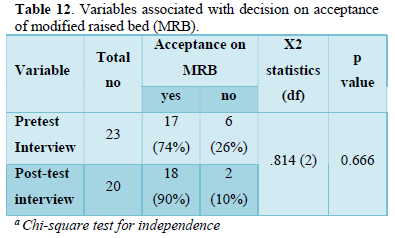
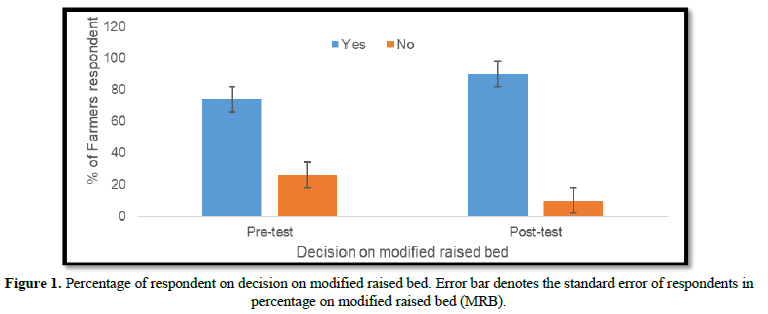
Table 13 showed that the acceptance intercropping of beans in modified raised bed between pre-test and post-test interview was not significantly different (p = 0.676). Therefore, there was no significant association between pretest and post-test interviews on acceptance of intercropping of beans in modified raised bed. The data (Figure 2) revealed that 45% of the farmers indicated in the post-test that they had made the decision to intercrop with beans in a modified raised bed. This was significantly higher than the 17% of farmers who had stated this in the pre-test interview. Those farmers who accepted the new techniques indicated that chili intercropped with beans in the modified raised bed had a higher yield and more uniform plant stands. The 55% of farmers who did not accept these techniques emphasized that the main chili crop intercropped with beans was not healthy (27% of farmers), not uniform (20%) and the chili plants were crushed by the beans plants (8%).
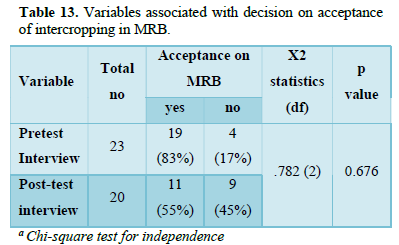
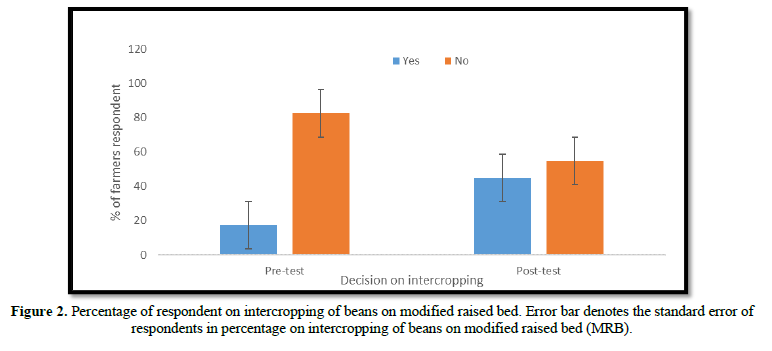
The result showed that the acceptance pruning in modified raised bed between pre-test and post-test interview was significantly different (p = 0.031). Therefore, there was significant association between pretest and post-test interviews on acceptance of pruning in modified raised bed (Table 14). The results indicated that, in the post-test, 70% of the farmers who had accepted the techniques of pruning in the modified raised beds (Figure 3). This was substantially lower than 96 % identified in the pretest. Some of the reasons for not accepting these techniques were low yield, indicated by 10% of the farmers, the stand was not uniform, (5%), more farm labor was required and it was more time consuming (10%), and weak plants resulted (5%). The farmers accepted pruning in post-test interview mainly for conducting the trial (50%) and yield (20%).
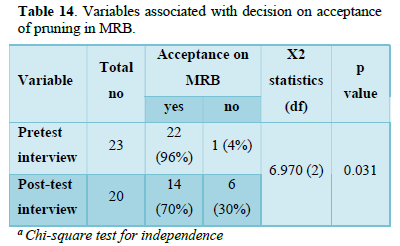
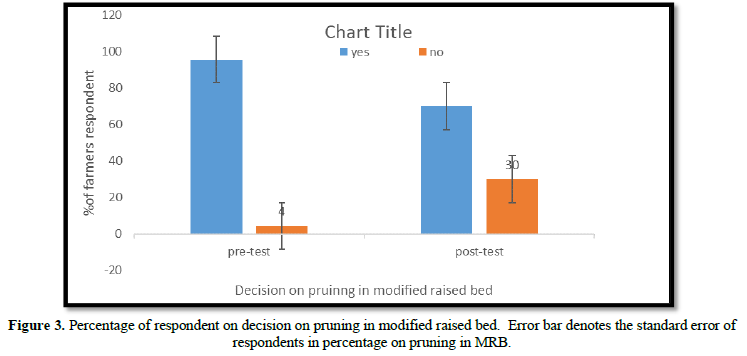
The findings found that there was no significantly different (p = 0.305) in acceptance of 1st bottom three flower removal in modified raised bed (MRB) between pretest and post-test interviews. Thus, there was no relation between interviews and the acceptance of 1st bottom three flower removal in MRB. As shown in Figure 4, about 96% of the farmers accepted decision on 1st bottom three flower removal of chili in modified raised bed and 4 % did not accept in pretest but after demonstration only 50% of farmers wanted to carry out flower removal. Even though a high percentage of farmers found good performance in plant growth (80%), number of fruits per plant (90%), fruit size (80%), plant health (80%) and overall yield (85%), 35% farmers found consuming more time and 15% farmers said no work force for removing flowers. The decrease of percentage of farmers from pretest to post-test who wanted to conduct pruning was because of easily acceptance with theory inputs in pre-test while in posttest farmers found more hectic, time consuming and more work-force requirement (Table 15).
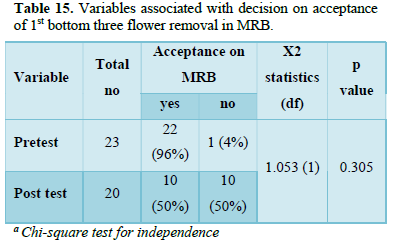
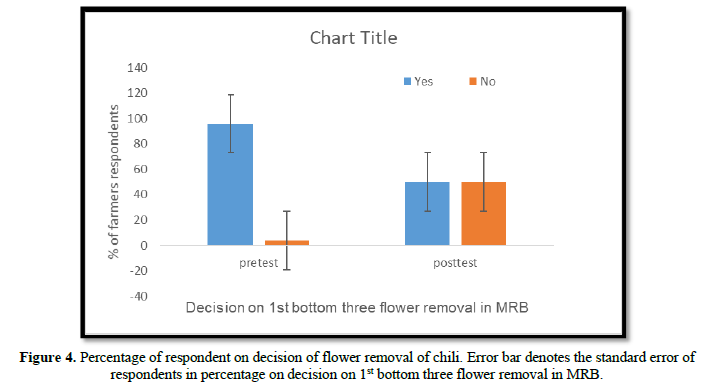
Table 16 showed no p value due to all farmers accepted at-least one technology in pre-test interview and could not compare with post-test interview. Figure 5 showed that, in the pre-test interview, all the farmers accepted to do at-least one of the techniques. However, in the post-test interview, 10% of farmers indicated that they did not accept any of the techniques. About 5% of the farmers observed lower yields, 3% found it to be too time consuming and 2% were concerned about the higher labor force requirement. From the remaining 90%, all these farmers wanted to carry out modified raised bed, 50% wanted to conduct 1st bottom three flower removal in modified raised bed, giving improved performance of plant growth and yield as the reason as shown in annexure 1-7. When enquired further about the adoption of the modified raised bed technology, some of the respondent farmers (38%) reported that healthy plant with the high yield could be due to high moisture in the soil, 36% mentioned about mulching with compost, 16% explained cultural operations such as weeding, hoeing and mulching and 10% said that nutrients with soil moisture. The finding is in line with Miernicki [26] who stated that soil water content increased with increasing rates of landscape bed of raised bed. As per Singh [27] planting crops in the ridge and furrows saved water (20%-25%), labour (30%-40%) and increase marketable yield (10%-20%) since this technique provided plants to grow healthy due to minimum water logging stress. These ridges and furrows functioned as drainage lines for excess water, facilitating modification of ridges and furrow feasible for poor soils with low water holding capacity. Jat [28] viewed that planting potatoes on both sides of a narrow bed increased yields by 25% and saved 20% of irrigation water as a comparison to ridge-planting method. Jat [28] further expressed that with adopting of bed planting technology saved 18-50% irrigation water, about 25% nitrogen and 25-50% seed. This finding clearly stated that the participating farmers had understood about the water retention capacity in the modified raised bed for the growth and development of chili plants under rain-fed farming. Thus, the majority of the participating farmers had accepted to adopt the modified raised bed.
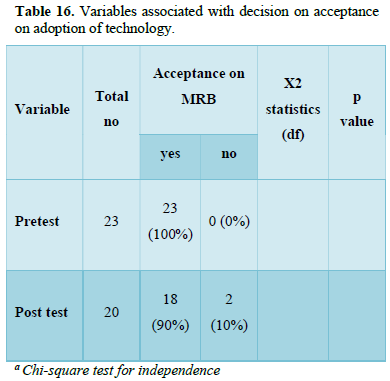
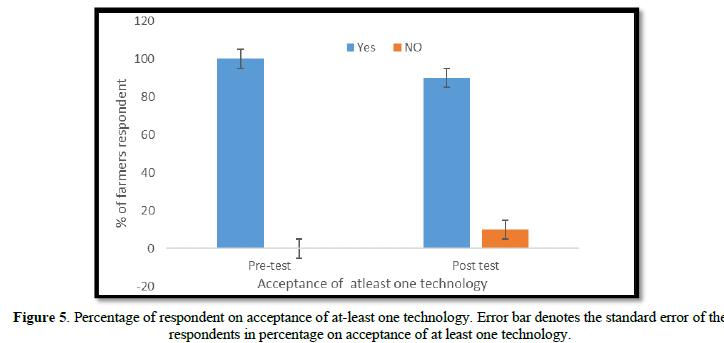
CONCLUSION
The majority of the respondents were middle aged with a high number being illiterate, with more female farmers than male. While the majority owned a medium sized landholding of 2-3 acres, most cultivated chili on less than one acre for both subsistence and commercial purpose. The majority grew chili in wet land allowing them to rotate chili after paddy. All the farmers raised their own seedlings in their own nurseries. All of them used raised planting beds and intercropping of chili with beans. However, they had no knowledge on pruning, 1st bottom three flower removal of chili and the differently structured raised bed. After providing this knowledge and giving the farmers the opportunity to observe the test trials plantings and outcomes, the majority of the farmers adopted the modified raised bed structure and the 1st bottom three flower removal technique in modified raised bed under rain-fed farming. A few of the farmers accepted the pruning and intercropping techniques on modified raised bed for trial purposes. The value of this research was to provide the farmers with information on tested methods and techniques for crop improvement under rain-fed farming.
ACKNOWLEDGEMENT
Many thanks to Mr Roy I. Morien of the Naresuan University Graduate School for his invaluable assistance in ensuring correct English expression and grammar.
- Patil DK (2016) Cropping Techniques. Agrotechnology 5: 2.
- Rana S, Rana M (2011) Cropping system. Department of Agronomy, College of Agriculture, CSK Himachal Pradesh Krishi Vishvavidyalaya, Palampur, 80.
- Alsadon A, Wahb-Allah M, Abdel-Razzak H, Ibrahim A (2013) Effects of pruning systems on growth, fruit yield and quality traits of three greenhouse-grown bell pepper (Capsicum annuum L.) cultivars. Austr J Crop Sci 7(9): 1309.
- Jovicich E, Cantliffe DJ, Stoffella PJ (2004) Fruit yield and quality of greenhouse-grown bell pepper as influenced by density, container, and trellis system. Hort Technol 14(4): 507-513.
- Maboko M, Du Plooy C, Chiloane S (2012) Effect of plant population, stem and flower pruning on hydroponically grown sweet pepper in a shade net structure. Afr J Agric Res 7(11): 1742-1748.
- Ueda A, Samdup T (2010) Chili transactions in Bhutan: An Economic, social and cultural perspective. Bull Tibetol pp: 103-118.
- Krejcie RV, Morgan DW (1970) Determining sample size for research activities. Educ Psychol Meas 30(3): 607-610.
- Olayiwola O (2014) An Economic Analysis of Chili Crop Production in Ilora Area of Oyo State. Int Month Refer J Res Manag Technol 3: 153753333.
- Xinhua (eds Xuequan M) (2020) Bhutan farmers earn good living from chili production. Asia and pacific news. Available online at: www.xinhuanet.com
- Agriculture Research and Extension Division (2019). Department of Agriculture. Ministry of Agriculture and Forest. Available online at: http://dare.nic.in/
- Berke T, Black L, Talekar N, Wang J, Gniffke P, et al. (2005) Suggested cultural practices for chili pepper. AVRDC Pub pp: 05-620.
- Ning X, Guoqin H (2013) Effects of Paddy Field Rotation on Diseases, Pests and Weeds of Rice. Plant Dis Pest 4(4): 20-24.
- Groenman-van W, Geel VB (2017) Raised bed agriculture in northwest Europe triggered by climatic change around 850 BC: A hypothesis. Environ Archaeol 22(2): 166-170.
- Miah MM, Hossain S, Duxbury J, Lauren J (2015) Adoption of raised bed technology in some selected locations of Rajshahi District of Bangladesh. Bangladesh J Agric Res 40(4): 551-566.
- Hobbs PR, Giri GS (1997) Reduced and zero-tillage options for establishment of wheat after rice in South Asia Wheat: Prospects for global improvement. Springer pp: 455-465.
- Fahong W, Xuquing W, Sayre K (2003) Comparison study on two different planting methods for winter wheat in China. Bed planting course, CIMMYT, Mexico.
- Wang SW, Curtis PD, Lassoie JP (2006) Farmer perceptions of crop damage by wildlife in Jigme Singye Wangchuck National Park, Bhutan. Wildlife Soc Bull 34(2): 359-365.
- Sahoo S, Mohnot S (2004) A survey of crop damage by Rhesus monkeys (Macaca mulatta) and Hanuman langur (Semnopithecus entellus) in Himachal Pradesh, India. Tiger Paper 31(4): 1-7.
- Stagnari F, Maggio A, Galieni A, Pisante M (2017) Multiple benefits of legumes for agriculture sustainability: An overview. Chem Biol Technol Agric 4(1): 2.
- Bakhsh A, Chauhdary JN, Ahmad N (2018) Improving Crop Water Productivity of Major Crops by Adopting Bed Planting in Rechna Doab Pakistan. Pak J Agric Sci 55(4): 965-972.
- Singh I, Kaur A (2018) Effect of pruning systems on growth and yield traits of greenhouse grown bell pepper (Capsicum annuum L. var. grossum). Indian J Agric Res 52(4): 414-418.
- Fabunmi TO, Adigbo SO, Odedina JN (2010) Effect of Severity of Pruning on Growth, Yield and Survivability of Pigeon Pea (Cajanus Cajan) In Pigeon Pea/Pepper Alley Cropping. Vol: 10 (1).
- Neuhoff D, Tashi S, Rahmann G, Denich M (2014) Organic agriculture in Bhutan: potential and challenges. Org Agric 4: 209-221.
- Ghebremariam TT (2005) Yield and Quality Response of Tomato and Hot Pepper to Pruning. Faculty of Natural and Agricultural Sciences. University Of Pretoria, Pretoria.
- Ouma G, Jeruto P (2010) Sustainable horticultural crop production through intercropping: The case of fruits and vegetable crops: A review. Agric Biol J North Am 1(5): 1098-1105.
- Miernicki EA, Lovell ST, Wortman SE (2018) Raised Beds for Vegetable Production in Urban Agriculture. Urban Agric Reg Food Sys 3(1): 1-10.
- Singh S, Singh D, Velmurugan A, Jaisankar I, Swarnam T (2008) Coping with Climatic Uncertainties Through Improved Production Technologies in Tropical Island Conditions Biodiversity and Climate Change Adaptation in Tropical Islands. Elsevier pp: 623-666.
- Jat ML, Dagar JC, Sapkota TB, Govaerts B, Ridaura S, et al. (2016) Climate change and agriculture: Adaptation strategies and mitigation opportunities for food security in South Asia and Latin America Advances in agronomy. Elsevier 137: 127-235.
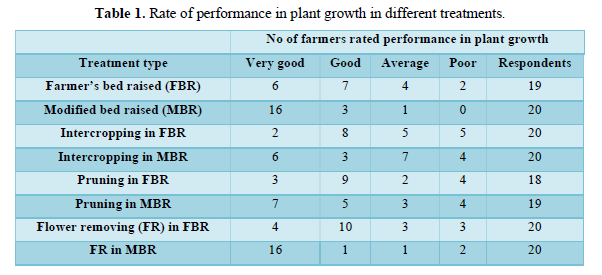
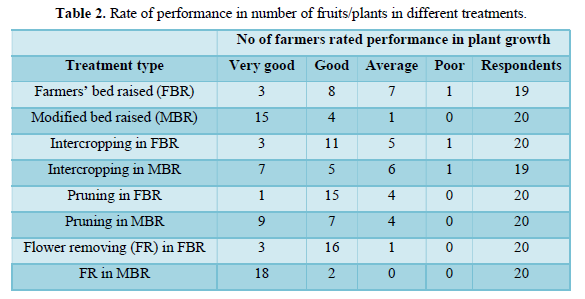
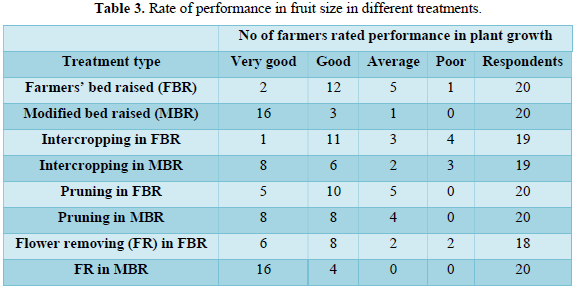
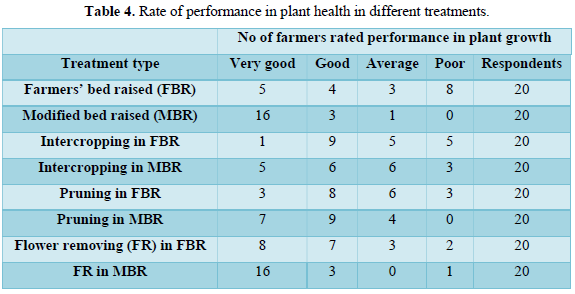
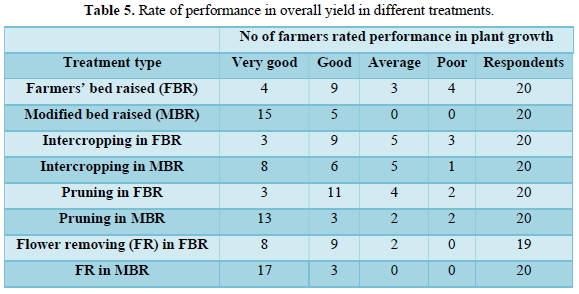

QUICK LINKS
- SUBMIT MANUSCRIPT
- RECOMMEND THE JOURNAL
-
SUBSCRIBE FOR ALERTS
RELATED JOURNALS
- Journal of Veterinary and Marine Sciences (ISSN: 2689-7830)
- Journal of Womens Health and Safety Research (ISSN:2577-1388)
- Journal of Genetics and Cell Biology (ISSN:2639-3360)
- Proteomics and Bioinformatics (ISSN:2641-7561)
- Food and Nutrition-Current Research (ISSN:2638-1095)
- Advances in Nanomedicine and Nanotechnology Research (ISSN: 2688-5476)
- Journal of Biochemistry and Molecular Medicine (ISSN:2641-6948)





